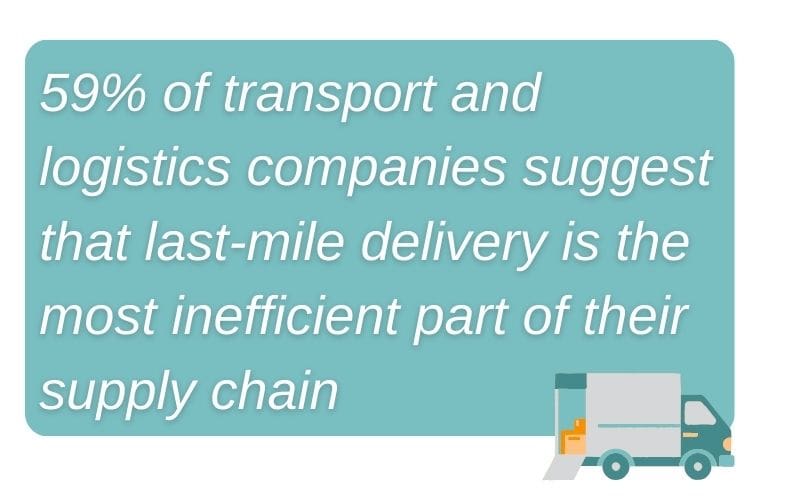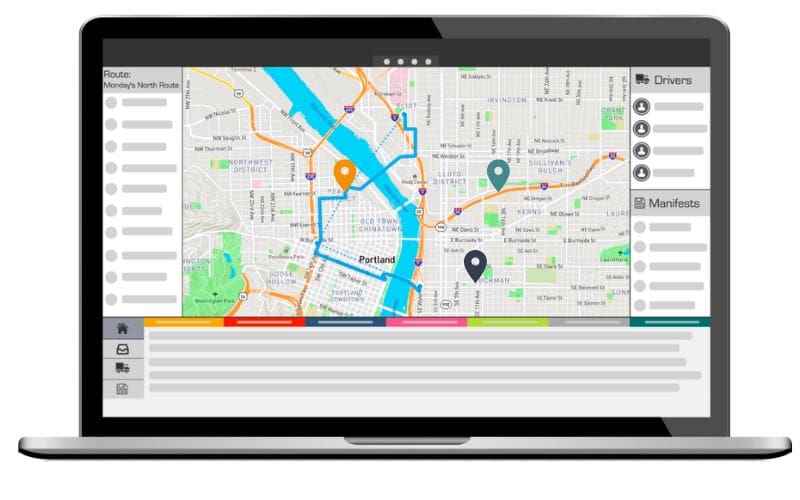
In modern-day logistics, offering last-mile delivery is essential. Beyond expecting products to be delivered to their doorstep, consumers want it done in record time. But despite accounting for a small proportion of the journey packages have to travel, last-mile issues can ruin the outcomes.

According to a GlobalNewsWire report, 59% of transport and logistics companies suggest that last-mile delivery is the most inefficient part of their supply chain. Therefore, successfully navigating last-mile complexities will give you a competitive edge.
Keep reading to discover the top last-mile delivery issues and how to address them to take your logistics company to the next level.
1. Tackling Last-Mile Traffic Congestion
In areas such as Dayton, Winston Salem, and Kansas City, drivers lose an average of 11 hours annually due to traffic jams. For last-mile deliveries, every minute counts. Let’s examine why:
First, delays can significantly impact customer experience and brand reputation. This will then affect your business’s long-term prospects. Second, the longer drivers spend in traffic jams, the fewer packages they can deliver, reducing your order fulfillment capacity.
Given that traffic congestion directly impacts delivery times and overall fulfillment and revenues, addressing it should be a top priority. In this regard, leveraging technology is essential. There are advanced logistics navigation tools that offer:
- Real-Time Traffic Updates: Integrating advanced technology for real-time traffic updates enables on-the-fly adjustments to delivery routes, steering vehicles away from congested areas.
- GPS and Navigation Apps: Equipping drivers with GPS and navigation apps empowers them with live traffic data, allowing for dynamic rerouting to avoid bottlenecks.
In addition to such solutions, there are navigation strategies you can implement to enhance efficiency. These include:
- Route Optimization: This involves using complex algorithms to identify the most time-efficient paths through congested areas, ensuring minimal disruptions.
- Time Slot Optimization: Carefully scheduling delivery time slots based on traffic patterns can mitigate the impact of congestion, enhancing overall delivery efficiency.
By embracing technology and strategic planning, you’ll pave the way for a smoother and more punctual last-mile delivery experience.
2. Overcoming Last-Mile Delivery Delays
Aside from missing or damaged items, delivery delays are the top complaint for customers. But this is not a last-mile issue that only stems from traffic jams. Numerous factors can contribute to delayed deliveries.
To ensure you can consistently offer prompt and reliable deliveries, addressing the common causes of delay is crucial. They include:
- Unforeseen Events: External factors such as accidents, road closures, or adverse weather conditions can lead to unexpected delays. Incorporating real-time updates into route planning helps anticipate and navigate around these hurdles.
- Inefficient Route Planning: Suboptimal route planning can result in extended travel times and delays. Implementing advanced route optimization tools ensures that delivery routes are strategically planned for efficiency.
The first way to address these last-mile issues is by embracing predictive analytics. This involves leveraging data analytics to predict potential delays and enable proactive route adjustments, minimizing the impact on delivery timelines.
However, even with predictive analytics, unforeseen issues may arise… This is where dynamic scheduling comes into play. You begin with your base route but as your driver progresses, you can adapt delivery schedules based on real-time conditions. Doing so facilitates route optimization, which aids in timely deliveries.
As you can see, efficient last-mile logistics requires a flexible and multi-faceted approach. You must invest in understanding and identifying issues early on and then take proactive measures to address them.

3. Mitigating Failed Delivery Attempts
On average, every failed delivery will cost you roughly $10. However, that’s only the tip of the iceberg. Beyond the cost, the negative impact of failed deliveries on customer experience and loyalty will further compound the issue.
If a delivery fails, take the initiative to pinpoint the cause of the failure. Taking time to explore these issues will help shed light on effective solutions.
Some of the primary causes of failed deliveries include:
- Recipient Unavailability: Unsuccessful deliveries often occur because recipients are unavailable at the designated address. This common challenge requires tailored solutions to ensure successful handovers.
- Inaccurate Address Information: Incorrect or incomplete address details contribute significantly to delivery failures. Implementing systems to verify and rectify addresses before dispatch is essential.
- Lack of Communication: Limited communication between delivery personnel and recipients can lead to missed deliveries. Bridging this gap is crucial for ensuring successful handovers.
Solutions for Seamless Deliveries:
- Time-Sensitive Notifications: Implementing real-time notifications to recipients regarding impending deliveries enhances awareness and ensures recipients are available. Furthermore, automate these notifications to ensure customers have adequate information at all delivery stages.
- Interactive Communication Channels: Establishing two-way communication channels between delivery personnel and recipients allows for coordination and updates, reducing the likelihood of missed deliveries.
- Flexible Delivery Options: Offering flexible delivery time windows and alternative delivery locations provides recipients with options that align with their schedules.
- User-Friendly Tracking Platforms: Providing customers with easy-to-use tracking platforms empowers them to monitor and manage their deliveries actively.
Addressing the root causes and implementing customer-centric solutions can elevate last-mile delivery success rates and enhance overall customer satisfaction.
4. Decoding Last-Mile Expenses: Navigating the Cost
Considering that last-mile delivery directly impacts customer satisfaction, it’s easy to prioritize optimized delivery times. However, the goal should be to find the perfect balance between efficiency and cost.
This is because last-mile delivery accounts for 53% of your total shipping costs. Without addressing the cost factor, your efforts may not be financially feasible.
Some of the costs you’ll incur include:
- Personnel Costs: The workforce involved in last-mile delivery, including drivers and support staff, represents a significant portion of operational expenses.
- Fuel and Vehicle Maintenance: The cost of fuel and the maintenance of delivery vehicles directly impact the economic viability of last-mile logistics.
- Technology and Infrastructure: Investing in advanced route optimization, tracking, and communication technologies contributes to operational efficiency and costs.
Strategies for Cost Optimization:
- Route Optimization Technologies: Implementing sophisticated route optimization software minimizes fuel consumption and reduces delivery time, enhancing cost-effectiveness.
- Fleet Management Solutions: Leveraging fleet management technologies allows businesses to monitor vehicle performance, optimize maintenance schedules, and reduce unexpected repair costs.
- Automation in Operations: Integrating automation in various aspects of last-mile logistics, such as sorting and packing, reduces the reliance on manual labor, positively impacting costs.
Balancing Efficiency with Cost
The delicate equilibrium between cost efficiency and service quality is a perpetual challenge in last-mile logistics. You’ll need to go a step further and adopt strategies that optimize costs without compromising the integrity of delivery services.
- Service Customization: Tailoring delivery services to meet specific customer needs allows for more precise resource allocation, avoiding unnecessary costs.
- Strategic Partnerships: Collaborating with local businesses or leveraging third-party logistics services can be cost-effective, especially for smaller enterprises.
- Continuous Process Evaluation: Regularly reassessing and refining operational processes ensures ongoing efficiency gains and cost optimization.
Efficient cost management in last-mile delivery is a game-changer. It helps you cut down on unnecessary expenditures and optimize resource usage, making your operations more profitable without added investments.
5. Keeping Track of Last-Mile Deliveries in Real-Time
Aside from ensuring packages are delivered on time, you can enhance customer satisfaction by providing clarity along the way. Rather than leave clients anxious and constantly calling to find out how long it will take before their products arrive, leverage real-time tracking solutions.
Moreover, real-time tracking also benefits dispatchers as the visibility gives them increased control and enhanced decision-making. Here are some of the transformative aspects of real-time monitoring of last-mile delivery:
- Operational Precision: Real-time tracking provides logistics managers with up-to-the-minute insights into the location and status of deliveries, enabling proactive decision-making.
- Customer Assurance: Giving customers real-time visibility into their deliveries cultivates trust and satisfaction, critical elements in building long-lasting relationships.
Real-time tracking will also improve your communication with customers. By implementing automated communication systems, you can keep them informed about the status of their deliveries, reducing uncertainties and enhancing overall satisfaction.
In addition, you can use customized alerts to align communication with individual preferences, fostering a positive customer experience.
Implementing Advanced Tracking Systems

To enjoy maximum visibility of the packages in transit, you should take two key steps for enhanced real-time tracking.
- Use GPS technology: Leveraging GPS technology allows for accurate and reliable tracking, ensuring that deliveries are on course and in compliance with predetermined schedules.
- Integration with Logistics Software: Seamless integration with logistics software enhances the overall efficiency of tracking systems, creating a unified platform for monitoring and management.
Real-time tracking is not merely a technological feature but a strategic asset that elevates last-mile delivery to new heights. With the right approach, you can refine communication channels, optimize delivery operations, and boost customer confidence with advanced tracking systems.
6. Managing Returns Efficiently in Last-Mile Logistics
Over 10% of products bought online are returned to the retailer. As a result, the market value of the global reverse logistics sector is expected to reach $821.55 billion by 2025.
While returns are unfortunate, they’re a common last-mile issue and can increase operational costs if left unchecked. Along with ensuring the return cost is low enough to justify incurring it, you also want to offer a smooth process to retain customers.
However, this is easier said than done, as you’ll have to address the following challenges first:
- Product Condition Assessment: Evaluating the condition of returned items is crucial, as it determines whether the product can be restocked, refurbished, or requires disposal.
- Logistical Complexities: The reverse journey involves intricate logistical challenges, from arranging pick-ups to processing returned items and updating inventory.
The first step you should take is to establish clear return policies. Doing so gives customers clarity on the procedures to follow, reducing uncertainties and enhancing the overall returns experience.
Accompany your robust return policy with dedicated and efficient return centers. These should be equipped with advanced sorting and processing capabilities to facilitate the swift handling of returned items, minimizing disruptions to the supply chain.

Utilizing Technology for Optimization
As with other areas of your logistics operations, technology can play a vital role in the efficiency of your returns process.
- Barcode and RFID Integration: Implement barcode and RFID technology to enhance the traceability of returned items, providing real-time insights into their status and location.
- Automation in Processing: Automation streamlines the processing of returns, reducing manual efforts and expediting the identification, assessment, and reintegration of products into inventory.
Efficient returns management is integral to the holistic success of last-mile logistics. By addressing challenges, implementing clear policies, and embracing technology, you can transform returns from a potential setback into an opportunity for improved customer satisfaction and operational excellence.
7. Striking a Balance Between Sustainability and Efficiency
Drivers are racking up more miles to meet the rising demand for last-mile delivery, translating to congested roads and increased carbon production. Furthermore, the packaging used finds its way to landfills, compounding the environmental impact of last-mile delivery.
Sustainability isn’t just a last-mile issue that affects just your company, but society as a whole. Understanding and mitigating these concerns is crucial for your brand to achieve its eco-friendly objectives. Here are some of the ideal solutions:
- Alternative Fuels: Transitioning to alternative fuels, such as electric or hybrid vehicles, reduces carbon emissions and minimizes the ecological footprint of last-mile operations.
- Route Optimization: Efficient route planning reduces delivery times and decreases fuel consumption, contributing to lower emissions and overall environmental impact.
- Packaging Innovation: Adopting sustainable packaging materials and designs reduces waste generation and supports eco-conscious consumption.
- Collaboration for Efficiency: Partnering with local businesses and leveraging shared distribution networks can optimize routes and decrease the number of vehicles on the road.
Budgetary constraints are often the most significant challenge regarding sustainability efforts. However, with enough goodwill and ingenuity, you can identify cost-effective sustainability strategies achievable within your budget.
Doing so will boost your brand’s public perception as consumers increasingly favor businesses committed to sustainability.
Navigating Last-Mile Challenges for Optimal Delivery Solutions
As the last-mile delivery market continues to grow, there will be numerous opportunities to scale. But due to this sector’s nature, retaining customers will be more valuable than attracting new ones. Therefore, before implementing growth measures, develop systems and adopt a proactive approach to resolving last-mile issues.
From traffic congestion to sustainability concerns, addressing these issues strategically is the key to seamless operations. Moreover, getting this right will boost retention and brand perception, propelling your company’s growth.
At Elite EXTRA, we offer solutions designed to help you overcome last-mile issues. From route optimization to real-time tracking, Elite EXTRA empowers businesses to overcome challenges and elevate their delivery capabilities.
Request a demo today to find out how you can streamline last-mile delivery operations and optimize client satisfaction.s.
Sources:
https://www.globenewswire.com/news-release/2020/07/06/2057928/0/en/Last-Mile-Delivery-is-the-Most-Inefficient-Process-for-More-Than-Half-of-North-American-Transportation-Logistics-Companies.html
https://www.fdiintelligence.com /content/data-trends/traffic-time-the-worlds-most-congested-cities-82680
https://atos.net/wp-content/uploads/2021/09/LMD-Here-Survey.pdf
https://www.shopify.com /in/enterprise/reverse-logistics
https://www.statista.com /statistics/872773/e-commerce-reverse-logistics-cost-united-states/
https://www.fidelitone.com/last-mile-delivery/last-mile-logistics-problems-and-how-to-solve-them-once-and-for-all







